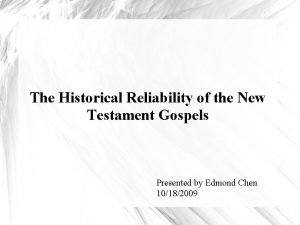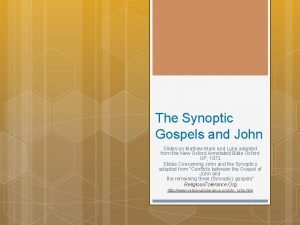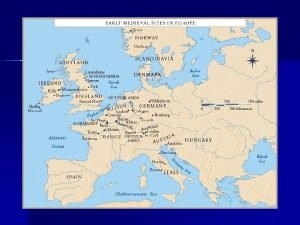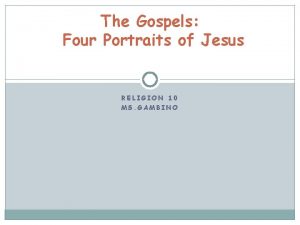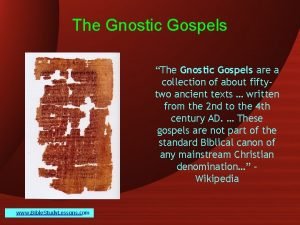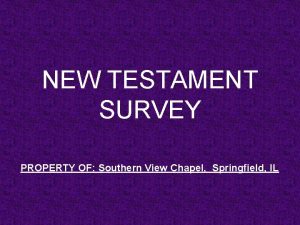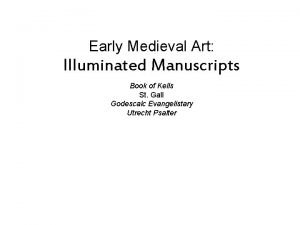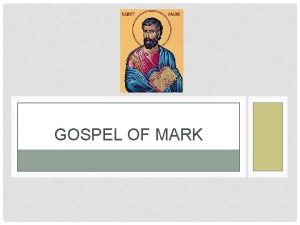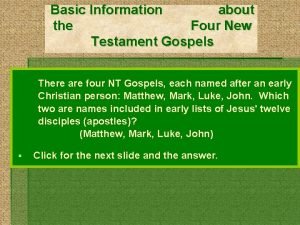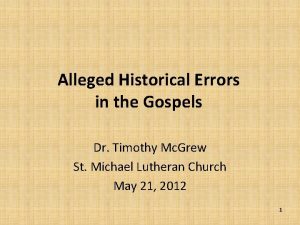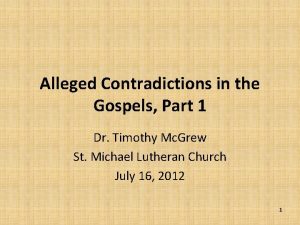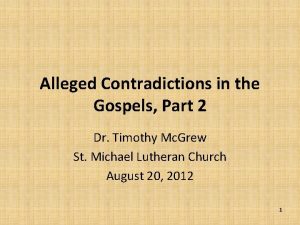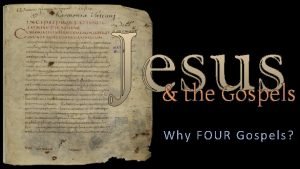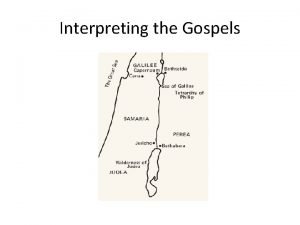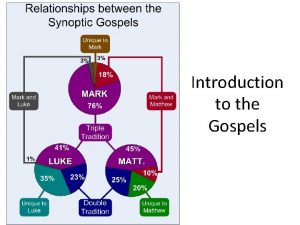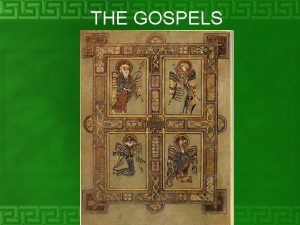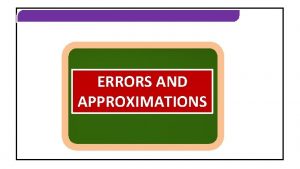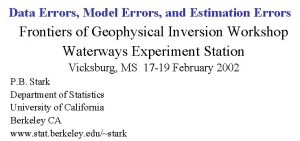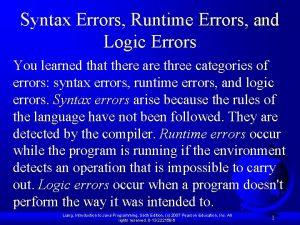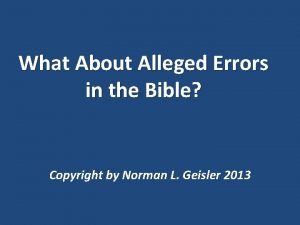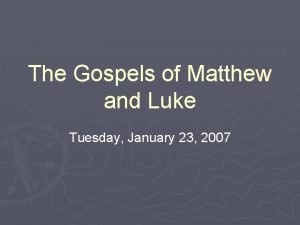Alleged Historical Errors in the Gospels Luke and



















































- Slides: 51

Alleged Historical Errors in the Gospels: Luke and John Dr. Timothy Mc. Grew St. Michael Lutheran Church June 11, 2012

Proverbs 18: 17 The one who states his case first seems right, until the other comes and examines him.

A map of the material External Positive Evidence Non-Christian sources Incidental confirmations Internal Undesigned Coincidences Other internal clues Objections Alleged historical errors Alleged contradictions in the Gospels between the Gospels

Our goals for this evening • To understand the challenge posed by the claim that Luke and John make repeated, significant historical errors. • To examine, from an historical point of view, several of the most common historical objections raised against them. • To assess the case for the genuineness and substantial historicity of the Gospels in the light of our investigation.

What we will not do this evening • We will not be discussing the various alleged discrepancies and contradictions among the Gospels. Our concern tonight is with the alleged mismatch between the Gospels and external sources of information. • The topic of alleged contradictions among the Gospels is reserved for the next lecture (or two), when we will treat it in detail.

The case against Luke 1. According to Luke, Caesar Augustus ordered a taxation of the whole Roman empire during the reign of Herod the Great; but Augustus never did this, and he could not have ordered a census just in Herod’s domain (Luke 2: 1) 2. Luke confuses this supposed census with one under Quirinius that took place about 12 years later (Luke 2: 1 -2) 3. Luke gives Pontius Pilate the wrong title, calling him “procurator” (ἡγεμών) instead of “prefect” (Luke 3: 1)

The case against Luke, continued 4. Luke claims that Lysanius was alive in about the year AD 27; but in fact, Lysanius died around 36 -34 BC (Luke 3: 1) 5. Luke speaks of Annas and Caiphas as high priests; but there was only ever one high priest at a time (Luke 3: 2) 6. Luke places a synagogue at Capernaum, but there was no synagogue there in Jesus’ time (Luke 7: 1 -5)

The case against Luke, continued 7. Luke is confused about the geographical locations of Galilee, Samaria, and Judea (Luke 17: 11)

Objection #1: Luke 2: 1 In those days a decree went out from Caesar Augustus that all the world should be registered. (In the NIV, “… the entire Roman world”) • Objection: Caesar Augustus never ordered all the world (or all the Roman world) to be registered.

Answer to objection #1 • What this verse says is that the whole οἰκουμένη – the whole “land” – was to be registered. • Luke uses this term, and nearly this same construction, in Acts 11: 28: . . . there would be a great famine over all the οἰκουμένη. . . But here, it clearly means the land of Judea, not the whole Roman empire.

Pressing objection #1 • Judea was under the control of Herod the Great, and as a client king in good standing, Herod would have been allowed to levy taxes himself. So Augustus would not have issued this decree. But was he “in good standing”?

Answer to the further objection • Near the end of his reign, Herod fell out of favor with Augustus, who sent him a sharply worded letter telling him that whereas he had treated him before as his friend, he would from that point on treat him as his subject (Josephus, Antiquities 16. 9. 3 (#290)). • Formally or in effect, Herod was demoted from rex socius to rex amicus and thus lost the authority to conduct his own taxing.

Answering the further objection • From Josephus we learn that at this time the Romans required an oath of allegiance to Caesar from the citizens of Herod’s domain (Antiquities 17. 4. 2). This would be a step in the reduction of Palestine from a kingdom to the status of a Roman province. • But within a year or so, as Josephus reports, Herod managed to get back into Augustus’s good graces.

Summary of the answer to objection #1 • The registration was probably only in Herod’s dominion, not empire-wide. • It may have been ordered when Herod fell out of favor with Augustus around 7 BC. • This explanation covers the oath of loyalty to Caesar that Josephus mentions, which is otherwise unexplained.

Objection #2: Luke 2: 2 This was the first registration when Quirinius was governor of Syria. • But Quirinius didn’t become governor of Syria until AD 6, ten years after Herod the Great was dead. How can a chronological blunder of ten or twelve years be explained?

Before we answer this objection … • Luke knows that Jesus was born during the reign of Herod the Great (Luke 1: 5) • Luke also knows about the taxation under Quirinius in AD 6 (Acts 5: 37) Any explanation of Luke’s language in Luke 2: 1 -2 must be compatible with these facts

Two possible answers 1. Quirinius may have had two periods as a governor of some sort in Syria; if so, Luke could be referring to the earlier period. 2. The Greek in this text does not actually claim that the well-known taxation under Quirinius took place in 6 BC.

Was Quirinius governor of Syria twice? • We know that Quintilius Varus was the governor of Syria from about 6 - 4 BC, and Gaius Sentius Saturninus was governor before him. So if Quirinius was a governor in Syria at the time when Jesus was born, he was there on an extraordinary appointment from Caesar. • Such extraordinary legates were known in Syria about this time. Josephus mentions a man named Volumnius, an associate of Saturninus, who was not the Senate’s appointed governor, but he calls them both “governors” (Antiquities 16. 9. 1, 2, 5).

Archaeological evidence • An inscription found at Tivoli describes someone (the name is lost at the beginning) who, “being a legate of Augustus for the second time received Syria and Phoenecia. ” • If this were a reference to Quirinius, it might indicate that he had been imperial legate earlier than AD 6. • But the grammar of the inscription indicates that it is this person’s second time as imperial legate, not his second time as governor of Syria. • So while this explanation is possible, it does not have any direct support.

Looking at the Greek more closely • Reading αὐτή for αὕτη, per Ebrard, Godet, etc. , The ἀπογραφή itself was first made … • The term ἀπογραφή can mean (1) a registration or (2) a taxation involving a registration. • An admissible reading of Luke’s Greek here is that Quirinius, a decade later, picked up where the matter was dropped in 6 BC and brought the taxation itself to pass. • Luke uses the verb ἐγένετο this way in Acts 11: 28.

Consequences of this reading • Luke’s passing mention of the ἀπογραφή in the time of Judas the Galilean (Acts 5: 37) does not have to be explained away. • Luke’s brief reference to the registration corresponds to Josephus’s allusion in Antiquities 17. 2. 4 to an oath of allegiance to Caesar in Judea near the end of the reign of Herod the Great—which would be taken at the time of a registration. • There is no need to pre-date the governorship of Quirinius to 6 BC. All apparent chronological discrepancies disappear.

Summary of the response to objection #2 • It may be that Quirinius had an official role in Syria both around 6 BC and around AD 6. • More probably, Luke intends to convey that although the census was aborted in 6 BC, it was picked up and carried through to its logical completion—the taxation itself—under Quirinius.

Objection #3: Luke 3: 1 In the fifteenth year of the reign of Tiberius Caesar, Pontius Pilate being governor of Judea, . . . • Luke uses the wrong term here: Pilate was technically a prefect (νομάρχης), not simply a governor (ἡγεμών).

Answering objection #3 • The term that Luke uses is not the technical term for “prefect, ” and before AD 44, the governor of Judea was (technically) a prefect. But the more general term that Luke uses is the common one. – Josephus, the Jewish historian, repeatedly uses ἡγεμών to describe Pilate and his predecessors in the same position (Antiquities 18. 3. 1 (#55), 18. 6. 5 (#177), etc. ) • Tacitus, the Roman historian, describes Pontius Pilate as “… one of our procurators …” (Annals 15. 44)

Objection #4: Luke 3: 1 again … and Herod being tetrarch of Galilee, and his brother Philip tetrarch of the region of Ituraea and Trachonitis, and Lysanias tetrarch of Abilene, … • But according to Josephus, Lysanias was tetrarch of Abila (Chalcis) from about 40 -36 BC, a full sixty years too early for the reference here.

Answering objection #4 • The coincidence of the name “Lysanias” and the tetrarchy of Abila/Abilene does not mean that the one mentioned by Luke and the one mentioned by Josephus are the same person. • An inscription found on a temple from the time of Tiberius (dating from 14 - 29 AD) names a Lysanias as the Tetrach of Abila, just as Luke has written.

The temple inscription at Abila • “For the salvation of the August lords and of all their household, Nymphaeus, freedman of Eagle Lysanias tetrarch, established this street and other things. ” – Corpus Inscriptionum Graecarum 4521

The significance of the Abila inscription • “August lords” is a joint title given only to the emperor Tiberius and Livia, the widow of his predecessor Augustus. • This title establishes the date of the inscription as between AD 14 (the year that Augustus died and Tiberius became sole emperor) and 29 (the year of Livia’s death). • So there was a different Lysanius who was tetrarch of Abilene right in the time Luke indicates (~AD 27).

Objection #5: Luke 3: 2 … during the high priesthood of Annas and Caiaphas, … • “[A]ny person being acquainted with the history and polity of the Jews, must have known that there never was but one high priest at a time, . . . ” –Robert Taylor, The Diegesis, 3 rd ed. (1845), p. 126.

Answering objection #5 • Annas (sometimes called Ananus) had held the office of high priest from AD 6 -15, but he was deposed by Pilate’s predecessor Gratus. • The Jews apparently accommodated Roman interference by speaking of both the current Roman appointee and the original ritually appointed Jewish priest as “high priests. ” • Josephus himself uses the same language, e. g. The Jewish War 2. 12. 6 (“And both Jonathan and Ananias, the high priests …”)

Objection #6: Luke 7: 1 -5 After he had finished all his sayings in the hearing of the people, he entered Capernaum. Now a centurion had a servant who was sick and at the point of death, who was highly valued by him. When the centurion heard about Jesus, he sent to him elders of the Jews, asking him to come and heal his servant. And when they came to Jesus, they pleaded with him earnestly, saying, “He is worthy to have you do this for him, for he loves our nation, and he is the one who built us our synagogue. ”

Robert M. Price on Synagogues and Pharisees in Capernaum “A major collision between the gospel tradition and archaeology concerns the existence of synagogues and Pharisees in pre 70 C. E. Galilee. Historical logic implies that there would not have been any, since Pharisees fled to Galilee only after the fall of Jerusalem. ” —Robert M. Price, The Incredible Shrinking Son of Man (2003), p. 14

Implications of the Gospel statements • Luke’s language suggests that the synagogue at Capernaum was a particularly impressive structure that required considerable funds to construct. • Other passages in the Gospels (e. g. Mark 1, Matthew 4) make it plain that Capernaum was Jesus’ principal base of operations in Galilee. • Have the Gospel authors been caught in a huge mistake?

Archaeologists on excavations at Capernaum “The first-century Capernaum synagogue in which Jesus preached has probably been found. Because more than one synagogue may have existed in Capernaum at this time, we cannot be sure that this new find was Jesus’ synagogue. But this recently discovered first-century building is certainly a likely candidate. . The conclusion that this was a firstcentury A. D. synagogue seems inescapable. ” —James F. Strange and Hershel Shanks, “Synagogue Where Jesus Preached Found at Capernaum, ” Biblical Archaeology Review 9 (1983).

Excavations at Capernaum Trench 25 at Capernaum, showing: • Limestone walls of the 4 th or 5 th century synagogue (A), • Basalt wall of the 1 st century synagogue (B), and • Cobbled pavement of the 1 st century synagogue (C)

The synagogue at Capernaum • The walls of the 1 st century synagogue at Capernaum are unusually thick—well over a meter—and its floor plan shows it to have been a building with an interior space of nearly 450 square meters, larger than most 1 st century synagogues discovered elsewhere in Galilee. • This fits very well with the implication in Luke 7: 1 -5 that this synagogue was particularly magnificent.

Objection #7: Luke 17: 11 On the way to Jerusalem he was passing along between Samaria and Galilee. • Samaria lies between Galilee and Judea. So why would Jesus travel along the border between Samaria and Galilee in order to get to Jerusalem?

A curious remark from a critic • between Samaria and Galilee. This phrase enshrines Luke’s “geographical ineptitude” (see p. 164), and it is not easy to explain what is meant here. – Joseph Fitzmyer, The Gospel According to Luke XXXIV (New York: Doubleday, 1985), p. 1152 If it is not even clear what Luke means, how can it be clear that he is making a mistake?

Why Jesus might have avoided Samaria • The Samaritans were actively hostile to the Jews; in AD 52, Samaritans killed some Jewish pilgrims from Galilee. • In Luke 9: 51 ff, some Samaritans refuse to welcome Jesus because they can see he intends to go to Jerusalem. • To travel east along the border would keep Jesus and his disciples near fresh water.

The case against John 1. John gets the location of Bethany wrong, placing it to the east of the Jordan, whereas it was on the west side of the Jordan (John 1: 28) 2. John’s description of relations between Jews and Christians is anachronistic; the Christians were not expelled from the Jewish synagogues until ~AD 90, two generations after Jesus lived (John 9: 22)

Objection #1: John 1: 28 These things took place in Bethany across the Jordan, where John was baptizing. • But Bethany is located just two miles from Jerusalem, on the Mt. of Olives, not across the Jordan.

Answering objection #1 • John’s description is perfectly clear: he is referring to a Bethany beyond Jordan. • Two hundred years after Jesus’ death, the church father Origen tried to locate some of the geographical locations in Palestine. It is not surprising that he could not find them all. • This provides no reason for doubting the accuracy of John’s reference.

Objection #2: John 9: 22 His parents said these things because they feared the Jews, for the Jews had already agreed that if anyone should confess Jesus to be Christ, he was to be put of the synagogue. • Since our first record of an official Jewish exclusion of Christians from the synagogues dates to around AD 90, isn’t this a serious chronological error?

Answering objection #2 • According to Jewish tradition, some time around AD 90, Jewish leaders modified a congregational prayer to include an anathema on “Nazarenes and heretics. ” • But there is no reason to take John 9: 22 as referring to this (later) modification of the prayer. The difficulty arises only from the assumption that John and the Jewish sources are referring to the same event.

Contrasting the two events John’s report • Deliberate decision to throw people out Jewish anathema • Modification of a congregational prayer • Directed against those • Directed against who believed Jesus was “Nazarenes and the Messiah heretics” • ~AD 30 • ~AD 90

A review of the objections to Luke 1. Caesar Augustus and the registration (2: 1) – Probably a regional registration caused by Herod’s falling out with Caesar 2. Quirinius and the registration (2: 2) – Probably Luke is contrasting the initial registration with the later well-known taxation under Quirinius 3. Pilate, prefect vs. governor (3: 1) – Luke uses the same terminology as other writers; the fact that he uses a general term is not a problem

Review of objections to Luke, cont’d 4. Lysanias, tetrarch of Abeline (3: 2) – Archaeological evidence indicates that Luke and Josephus were referring to two different people 5. Ananias and Caiphas high priests (3: 2) – Luke’s usage again conforms to Josephus’s usage, and Josephus helps us to understand why the Jews would speak this way 6. The synagogue at Capernaum (7: 1 -5) – Objection killed by archaeological discovery of the foundation of a first century synagogue in Capernaum 7. The geography of Palestine (17: 11) – Luke’s description makes perfectly good sense

A review of the objections to John 1. The location of Bethany (1: 28) – John’s explicit designation of this Bethany as “beyond Jordan” indicates that he means a different location from Bethany near Jerusalem, to which he also refers (11: 18) 2. The exclusion of followers of Jesus from the synagogue (9: 22) – There is no reason to think that John’s remark has anything to do with the much later alteration of the Jewish congregational prayer

The alleged historical errors in the Gospels • In these two lectures, we have surveyed seven historical objections to Mark, three to Matthew, seven to Luke, and two to John—nineteen objections overall. • Not one of these objections has held up to investigation as an historical error on the part of the writer. • Frequently, the objections arise from misreadings, conflation of distinct events and people, or the critic’s inadequate knowledge of archaeology and geography.

The verdict • Since we have taken these objections from the writings of skeptics, we have every reason to think that they represent the best criticisms at their disposal. • We have every reason, on purely historical grounds, to consider the Gospels to be substantially trustworthy historical documents, written by authors who were well informed and habitually truthful.

Want more? For more resources, please visit http: //historicalapologetics. org And http: //apologetics 315. com On Facebook, you can “Like” the Library of Historical Apologetics
 The historical reliability of the gospels
The historical reliability of the gospels Synoptic gospels
Synoptic gospels St matthew ebbo gospels
St matthew ebbo gospels 4 portraits of jesus in the gospels
4 portraits of jesus in the gospels David e pratte theology
David e pratte theology Southern view chapel
Southern view chapel The virgins memo genius
The virgins memo genius Ebbo gospels
Ebbo gospels Comparing the four gospels
Comparing the four gospels Synoptic gospels
Synoptic gospels List the synoptic gospels
List the synoptic gospels Synoptic gospels
Synoptic gospels Gospels
Gospels Business confidence definition
Business confidence definition Four new testament gospels
Four new testament gospels Is the triumphal entry in all four gospels
Is the triumphal entry in all four gospels Hình ảnh bộ gõ cơ thể búng tay
Hình ảnh bộ gõ cơ thể búng tay Slidetodoc
Slidetodoc Bổ thể
Bổ thể Tỉ lệ cơ thể trẻ em
Tỉ lệ cơ thể trẻ em Gấu đi như thế nào
Gấu đi như thế nào Thang điểm glasgow
Thang điểm glasgow Bài hát chúa yêu trần thế alleluia
Bài hát chúa yêu trần thế alleluia Môn thể thao bắt đầu bằng chữ f
Môn thể thao bắt đầu bằng chữ f Thế nào là hệ số cao nhất
Thế nào là hệ số cao nhất Các châu lục và đại dương trên thế giới
Các châu lục và đại dương trên thế giới Công thức tính độ biến thiên đông lượng
Công thức tính độ biến thiên đông lượng Trời xanh đây là của chúng ta thể thơ
Trời xanh đây là của chúng ta thể thơ Mật thư tọa độ 5x5
Mật thư tọa độ 5x5 101012 bằng
101012 bằng độ dài liên kết
độ dài liên kết Các châu lục và đại dương trên thế giới
Các châu lục và đại dương trên thế giới Thơ thất ngôn tứ tuyệt đường luật
Thơ thất ngôn tứ tuyệt đường luật Quá trình desamine hóa có thể tạo ra
Quá trình desamine hóa có thể tạo ra Một số thể thơ truyền thống
Một số thể thơ truyền thống Cái miệng nó xinh thế
Cái miệng nó xinh thế Vẽ hình chiếu vuông góc của vật thể sau
Vẽ hình chiếu vuông góc của vật thể sau Thế nào là sự mỏi cơ
Thế nào là sự mỏi cơ đặc điểm cơ thể của người tối cổ
đặc điểm cơ thể của người tối cổ Thế nào là giọng cùng tên? *
Thế nào là giọng cùng tên? * Vẽ hình chiếu đứng bằng cạnh của vật thể
Vẽ hình chiếu đứng bằng cạnh của vật thể Tia chieu sa te
Tia chieu sa te Thẻ vin
Thẻ vin đại từ thay thế
đại từ thay thế điện thế nghỉ
điện thế nghỉ Tư thế ngồi viết
Tư thế ngồi viết Diễn thế sinh thái là
Diễn thế sinh thái là Dot
Dot Bảng số nguyên tố lớn hơn 1000
Bảng số nguyên tố lớn hơn 1000 Tư thế ngồi viết
Tư thế ngồi viết Lời thề hippocrates
Lời thề hippocrates Thiếu nhi thế giới liên hoan
Thiếu nhi thế giới liên hoan
